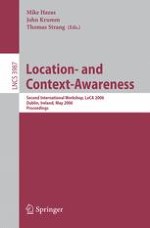nd These proceedings contain the papers presented at the 2 International Workshop on Location- and Context-Awareness in May of 2006. As computing moves increasingly into the everyday world, the importance of location and context knowledge grows. The range of contexts encountered while sitting at a desk working on a computer is very limited compared to the large variety of situations experienced away from the desktop. For computing to be relevant and useful in these situations, the computers must have knowledge of the user’s activity, resources, state of mind, and goals, i.e., the user’s context, of which location is an important indicator. This workshop was intended to present research aimed at sensing, inferring, and using location and context data in ways that help the user. Our call for papers resulted in 74 submissions, each of which was assigned to members of our Program Committee. After reviews and email discussion, we selected 18 papers for publication in these proceedings. Most of the accepted papers underwent a shepherding process by a reviewer or a member of the Program Co- ittee to ensure that the reviewers’ comments were accounted for in the published version. We feel our selective review process and shepherding phase have resulted in a high-quality set of published papers. We extend a sincere “thank you” to all the authors who submitted papers, to our hard-working Program Committee, our thoughtful reviewers, and our conscientious shepherds. May 2006 Mike Hazas and John Krumm, Program Co-chairs Thomas Strang, Workshop Chair
